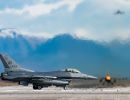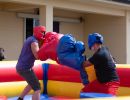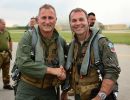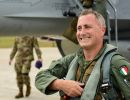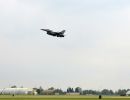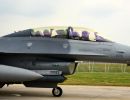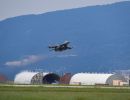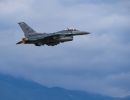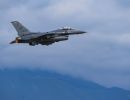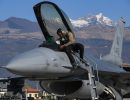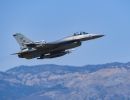Deny Flight enforced the no-fly zone, provided close air support to UN troops, and conducted approved air strikes under a "dual-key" command arrangement with the UN. NATO Airborne Early Warning and Control (AWACS) aircraft began monitoring operations in October 1992, in support of UN Security Council Resolution 781, which established a no-fly zone over Bosnia-Herzegovina. Data on possible violations of the no-fly zone has been passed to the appropriate UN authorities on a regular basis.
On 31 March 1993, the UN Security Council passed Resolution 816 authorising enforcement of the no-fly zone over Bosnia-Herzegovina and extending the ban to cover flights by all fixed-wing and rotary-wing aircraft except those authorised by UNPROFOR. In the event of further violations, it authorised UN member states to take all necessary measures to ensure compliance. An enforcement operation, called "Deny Flight", began on 12 April 1993. It initially involved some 50 fighter and reconnaissance aircraft (later increased to over 100) from various Alliance nations, flying from airbases in Italy and from aircraft carriers in the Adriatic. By the end of December 1994, over 47,000 sorties had been flown by fighter and supporting aircraft.
On 28 February 1994, four warplanes violating the no-fly zone over Bosnia-Herzegovina were shot down by NATO aircraft. This was the first military engagement ever undertaken by the Alliance.
In June 1993, NATO Foreign Ministers decided to offer protective air power for the United Nations Protection Force (UNPROFOR) in the performance of its overall mandate. In July, NATO aircraft began flying training missions for providing such Close Air Support (CAS). On 10 and 11 April 1994, following a request from the UN Force Command, NATO aircraft provided Close Air Support to protect UN personnel in Gorazde, a UN-designated safe area in Bosnia-Herzegovina.
At the January 1994 Brussels Summit, Alliance leaders reaffirmed their readiness, under the authority of the UN Security Council and in accordance with the decisions of the North Atlantic Council of 2 and 9 August 1993, to carry out air strikes in order to prevent the strangulation of Sarajevo, the safe areas and other threatened areas in Bosnia-Herzegovina. On 9 February 1994, the North Atlantic Council condemned the continuing siege of Sarajevo and decided to carry out air strikes against any further use of artillery and mortars in and around Sarajevo. The heavy weapons of any of the parties remaining in an area within 20 kilometres of the centre of the city after 20 February, would be subject to NATO air strikes conducted in close coordination with UNPROFOR.
On 21 February, following the expiry of the above deadline, NATO's Secretary General announced that the objectives set on 9 February were being met and that UN and NATO officials had recommended that air power should not be used at that stage.
In response to a written request by the UN Secretary General, the North Atlantic Council took further decisions on 22 April to support the UN in its efforts to end the siege of Gorazde and to protect other safe areas. These decisions were made public in two separate statements, issued by the Council.(1) Unless Bosnian Serb attacks against the safe areas of Gorazde ceased immediately, and Bosnian Serb forces withdrew three kilometres from the centre of the city by 00:01 GMT on 24 April, and unless humanitarian relief convoys and medical assistance teams were allowed free access by the same date, the Council announced that the Commander in Chief of Allied Forces Southern Europe was authorised to conduct air strikes against Bosnian Serb heavy weapons and other military targets within a 20-kilometre radius of Gorazde, in accordance with the procedural arrangements worked out between NATO and UNPROFOR following the Council's decisions of 2 and 9 August 1993.
It further declared that after 00:01 GMT on 27 April, specified military assets and installations would be subject to air strikes if any Bosnian Serb heavy weapons remained within a 20-kilometre exclusion zone around the centre of Gorazde. Regarding other UN-designated safe areas (Bihac, Srebrenica, Tuzla, and Zepa), the Council authorised air strikes if these areas were attacked by heavy weapons from any range. These other safe areas could also become exclusion zones if, in the common judgement of the NATO and UN Military Commanders, there was a concentration or movement of heavy weapons within a radius of 20 kilometres around them. These measures would be carried out using agreed coordination procedures with UNPROFOR (the so-called "dual key" system).
On 5 August, NATO aircraft attacked a target within the Sarajevo Exclusion Zone at the request of UNPROFOR. The air strikes were ordered following agreement between NATO and UNPROFOR, after weapons were seized by Bosnian Serbs from a weapons collection site near Sarajevo. On 22 September, following a Bosnian Serb attack on an UNPROFOR vehicle near Sarajevo, NATO aircraft carried out an air strike against a Bosnian Serb tank, at the request of UNPROFOR.
On 28 October 1994, following meetings in New York between UN and NATO officials, a joint statement was issued on understandings which had been reached concerning the use of NATO air power in Bosnia-Herzegovina in support of the relevant UN resolutions.
On 21 November 1994, NATO aircraft attacked the Udbina airfield in Serb-held Croatia. The air strike, conducted at the request of and in close coordination with UNPROFOR, was in response to recent attacks launched from that airfield against targets in the Bihac area of Bosnia-Herzegovina. It was carried out under the authority of the North Atlantic Council and United Nations Security Council Resolution 958.
Attacks on two NATO aircraft were launched from a surface-to-air missile site south of Otoka, in north-west Bosnia-Herzegovina. Following reconnaissance missions which demonstrated that the site posed a continued threat to aircraft participating in "Deny Flight", and in accordance with self-defence measures previously announced, an air strike was conducted against this site by NATO aircraft, in close coordination with UNPROFOR, on 23 November 1994.
On 24 November 1994, the North Atlantic Council also decided that NATO air power could be used, under the provisions of United Nations Security Council Resolution 958, against aircraft flying in Croatian air space which have engaged in attacks on or which threaten UN safe areas, subject to making arrangements with the Croatian authorities.
Capt. Scott F. O'Grady's F-16 was shot down by a surface-to-air missile south of the Bosnian city of Banja Luka 02 June 1995. He evaded capture by Bosnian Serb forces for six days before his rescue June 8 by a Marine Corps search and rescue team with multinational support. The mission O’Grady flew brought the eyes of the nation upon him at a time of national mourning over the Oklahoma City bombing. America needed a hero, and Scott O’Grady was that man. For six days the nation held it’s breath while efforts were conducted to ascertain his whereabouts and condition, and to arrange for his rescue. On the sixth day in a daring operation, the Army, Navy, Air Force and Marines combined their efforts and successfully rescued him -- twenty-five pounds lighter, dehydrated and physically reduced by severe hypothermia. The NATO multinational effort included support from about 40 aircraft including F-16C, F-15E, EF-111, A-10, KC-135R, HC-130 and MH-53J.
During Deny Flight operations, two Air Force NCOs received Purple Hearts for injuries while searching for two downed French pilots. Crews flying Air Force AC-130H gunships fired on targets enforcing UN restrictions in Bosnia. They also transported supplies and personnel into the country.
NATO's Deny Flight operation, enforcing the no-fly zone over Bosnia, terminated on December 20, 1995, when implementation force (IFOR) assumed responsibility for airspace over Bosnia. Operation Deny Flight transitioned to Decisive Edge in support of the IFOR Operation Joint Endeavor.

























